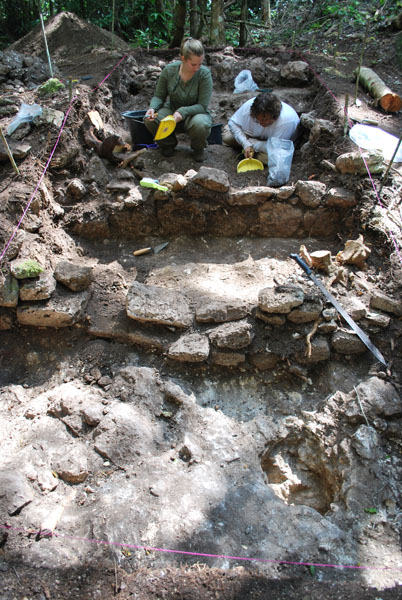Excavations continued in full force this week, being interrupted only on Saturday by rain.
In Alta Vista, the plaza excavation in front of Structure F35 was cleared down to bedrock. At the summit of Structure F35, two floors were found barely below ground surface and excavation into the building core began by week’s end, finding large rubble fill set into orange-colored marl. In Structure F34, evidence of an earlier version of the building was amplified. Besides the lower summit floor, a lower plaza floor was located – as was an earlier facing (or step) within the frontal building fill. On the summit, the crypt within the upper core of Structure 34 was exposed. It was also discovered that this burial cut through the lower summit floor and was lined on its sides with cut stones. Thus far, two vessels have been located on the south end of the crypt; the individual’s head is to the north, but the rest of the interment has yet to be excavated.
In Baja Vista, Structure F38 has had its western end excavated almost entirely to bedrock. A well-built construction wall, set directly on bedrock, was located behind the western step. Pieces of a Late Classic censer were recovered in the fill between the two facings. In the center of the structure is a flat floor that directly articulates with bedrock and may seal a deposit. A jadeite bead was located above this floor.
In the central spine group, which we have named “Chalpat” after the snake that was killed nearby, excavation continued in the northern and eastern buildings. In Structure F9, the north building, bedrock was located in front of the building step; it is uneven. Also encountered in the summit excavation has been a lower plastered floor and facing, indicating that there were at least two distinct versions of Structure F9. In the eastern Structure F11, excavation continued from the front part of the trench into the core of the building. No good architecture has yet been located and it appears as if the front part of this building has been disturbed. Large fragments of Late Classic censerware have been recovered here. On Friday, a burial also was located in the northeast corner of the trench, adjacent to what is probably a large capstone.
In the farthest group on the spine, which we have named “Ramon,” excavations continued in the eastern Structure F24. The three summit facings found last week were cut through, yielding two discontinuous earlier plastered floors. The easternmost upper floor is heavily burnt. Digging here has been complicated by large tree roots that must be removed. On Friday, excavation proceeded through the front slope of the structure through the fallen stairs. A new plaster floor was located on one side of the looter’s trench; it is at a higher level than the one that the looters had followed into the building (which was effectively at plaza level). We have yet to dig below plaza level in front of the structure.
This week we also laid out a 6.2 meter by 2 meter excavation on the central axis of the summit of Structure A1; it may be extended, as necessary. This investigation succeeded in finding a rear northern facing and three southern facings. The southernmost facing rose approximately 35 centimeters and was fairly intact; the surface abutting it was composed of orange-colored marl and not a plastered surface. This step was clearly cut through on its western side. Excavations into the dry core boulder fill in the area of the cut found the remains of a very disarticulated individual with teeth that were inlaid with jadeite and hematite. At a depth of approximately 2.5 meters below the ground surface a plaster floor was located below the area of the burial.








I think that I am overwhelmed in what you are doing, with all those careful digging and looking for those relics piece by piece would really gain you patience and perseverance in looking for those things which might also help n looking into something that we can use to resemble the past.
Kate from motoculteur occasion